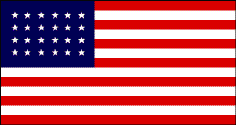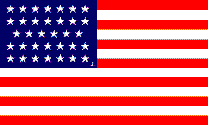 Old
Glory
Old
GloryDate: 1822 - 1836
Description: Thirteen red and white stripes. Twenty-four five-pointed stars in blue canton (6-6-6-6 pattern). [E08]
This flag was never made for the Clausen collection. The information provided here is for historical purposes.
Origin of the Name "Old Glory"
The flag of the United States was, at the time of its creation, one of the very few in the world containing stars and stripes. It is not surprising that it acquired the nicknames "The Stars and Stripes" and the "Star-Spangled Banner" many decades ago.
Old Glory as a name for the flag is an altogether different tale. At first it was a single flag that bore the name now familiar to all. The flag belonged to Capt. William Driver.
Driver had received this beautiful 24 star American flag in 1824 from his mother and her circle of sewers. At that time he was about to sail from his home port of Salem, Mass, on one of the trips he took around the world. As the banner opened to the ocean breeze for the first time, he exclaimed "Old Glory!"
Twice the flag went around the world. On one of his voyages, aboard the brig Charles Doggett, Capt. Driver rescued the survivors of the mutiny on the Bounty. He retired to Nashville in 1837, taking his treasured flag from his sea days with him.
 In
1860, the Captain's wife and daughter took the flag apart, cut off the
raveled and frayed seams, replaced the old stars and added new ones to
make 34 total (the correct number for the date) and an anchor
embroidered in the lower right corner of the canton. The last was to
commemorate Capt. Driver's sea service
In
1860, the Captain's wife and daughter took the flag apart, cut off the
raveled and frayed seams, replaced the old stars and added new ones to
make 34 total (the correct number for the date) and an anchor
embroidered in the lower right corner of the canton. The last was to
commemorate Capt. Driver's sea service
After countless voyages Capt. Driver retired from the sea and went to live in Nashville, Tennessee. Of course he took Old Glory with him and continued to display it on holidays such as Washington's Birthday, the 4th of July, and St. Patrick's Day (March 17, his own birthday as well). He and his flag became well known in Nashville.
When the Civil War broke out those who hoisted American flags in Nashville were attacked by Southern sympathizers. Confederate soldiers searched Drivers house several times for Old Glory, but never found it. When Union forces entered the city, however, Driver ripped open a bedspread and revealed his flag which had escaped any harm. Seeing it float from the top of the Capitol building in Nashville, Driver declared that he was ready to "meet his forefathers," knowing that Old Glory and Tennessee had been saved for the Union.
After the war the story of Capt. Driver's flag and its name spread by word of mouth and in books and newspapers. Although there is doubt about what eventually became of the original Old Glory, its name lives on in the hearts of millions of Americans.
Read more about the legend of Old Glory.